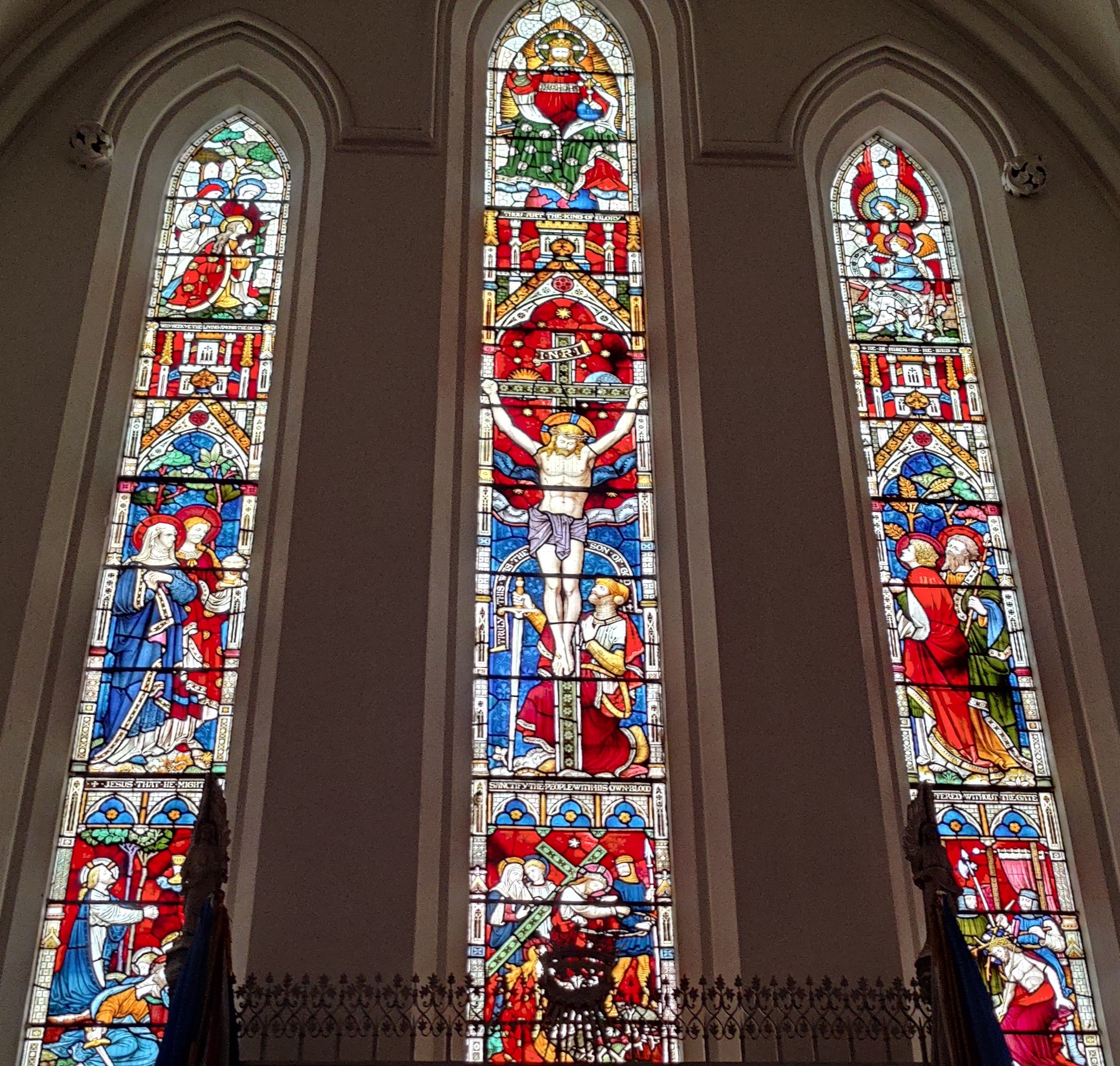This page is gradually being updated
Sanctuary Window - Colonel John Hynde King, Grenadier Guards
Deliverance Window
The De liverance Window is the rightmost window above the altar. It was made by Campbell Smith & Co and unveiled on 30 June 1882 attended by Queen Victoria, accompanied by Princess Beatrice, Princess Elizabeth & Princess Irene of Hesse. The central scene depicts Queen Victoria seated holding Sceptre of State in the right hand and an Indian chaplet in the left. The Angel of Mercy holding a sword lifts up a cloak hiding an assassin dressed as the grim Reaper of Death with sword in his right hand, broken in three pieces. The dedication reads “To the Glory of God and in grateful commemoration of the merciful deliverance of Her Gracious Majesty Queen Victoria on the 2nd of March 1882”.
liverance Window is the rightmost window above the altar. It was made by Campbell Smith & Co and unveiled on 30 June 1882 attended by Queen Victoria, accompanied by Princess Beatrice, Princess Elizabeth & Princess Irene of Hesse. The central scene depicts Queen Victoria seated holding Sceptre of State in the right hand and an Indian chaplet in the left. The Angel of Mercy holding a sword lifts up a cloak hiding an assassin dressed as the grim Reaper of Death with sword in his right hand, broken in three pieces. The dedication reads “To the Glory of God and in grateful commemoration of the merciful deliverance of Her Gracious Majesty Queen Victoria on the 2nd of March 1882”.
The window was placed in thanksgiving for Queen Victoria’s deliverance from an assassination attempt outside the Great Western (now Central) Railway Station in Windsor when Roderick Maclean attempted to fire a pistol at her. He was spotted and seized by two Eton Schoolboys who reportedly beat him with their umbrellas. At his trial Maclean was found “not guilty but insane” – the only possible verdict for someone who was judged to be insane. This led to a change in the law in 1883, at the request of Queen Victoria, which would allow a “guilty but insane” verdict in similar circumstances.
Of the two Eton schoolboys little is known of Leslie Robinson (or Roberts or Robertson) – the other was Gordon Wilson. Gordon was born in Victoria, Australia, in 1865. He was the son of a Sir Samuel Wilson a wealthy farmer/landowner and occasional politician. They moved to England in the late 1870s / early 1880s and took a lease on nearby Hughenden Manor in 1881 (home of former Prime Minister, Benjamin Disraeli, and now a National Trust property). Gordon joined the army, eventually becoming the Commanding Officer of the Royal Horse Guards (the Blues) – so Holy Trinity would have been his regiment’s church in Windsor. Gordon died from his wounds in November 1914 and is buried in Zillebeke Churchyard near Ypres. He is remembered, with many other members of his regiment, in a Book of Remembrance in Holy Trinity. Gordon’s wife was Lady Sarah Spencer-Churchill – she is well known for being one of the first female war correspondents and covering the siege of Mafeking (and was Winston Churchill’s aunt).
South Gallery Transept Window - Coldstream Guards
The centre light 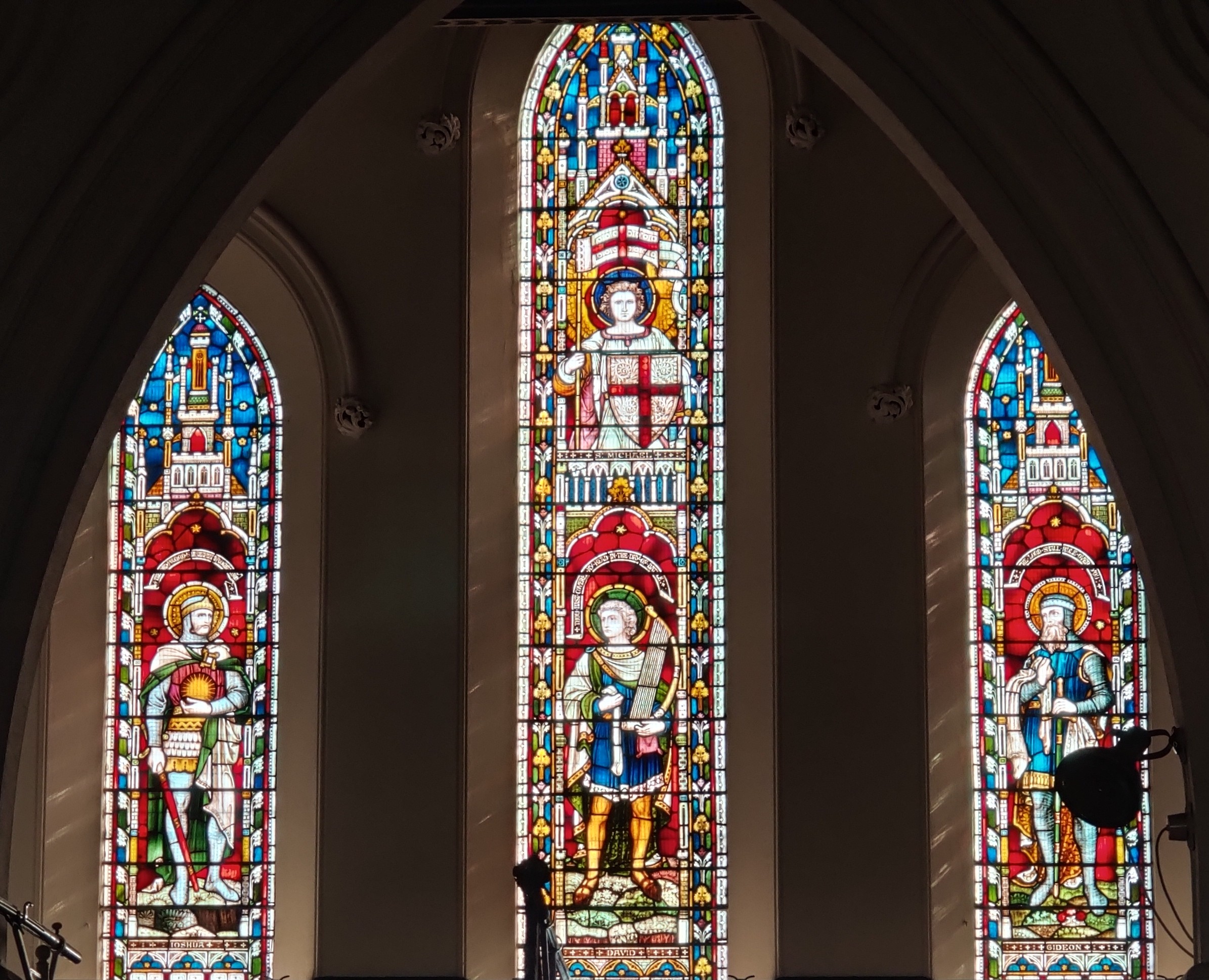 depicts David with St Michael above. The two lights either side depict Joshua and Gideon.
depicts David with St Michael above. The two lights either side depict Joshua and Gideon.
The window is dedicated to Lt Col Harvey Tower (21 Sep 1831 - 17 Nov 1870), Surgeon-Major John Wyatt (28 Oct 1825 - 2 Apr 1874) and Lt the Hon Alfred Walter Charteris (2 Jun 1847 - 23 Nov 1873) by the officers of the Coldstream Guards. Tower and Wyatt had distinguished careers in the Coldstream Guards and are interred in England. Sadly, Charteris died aged 26, serving as aide-de-camp to Major General Sir Garnet Wolseley in Africa, and is buried at sea.
The window is the work of Clayton & Bell (one of the most well known and highly regarded stained glass makers of the 1800s - the firm only ceased in 1993 with the death of the final descendant involved in it). There is no dedication on or near the window and it’s possible that, like the 1892 North Gallery Transept Window in memory of the Duke of Clarence, it was painted on the wall and subsequently painted over.
All four of the figures featured in the window could be thought of as “military saints”. St Michael also features in the centre of Holy Trinity’s chancel screen (this time with St Eustace and St Oswald either side of him).
Joseph being lifted out of the pit - South Gallery Transept
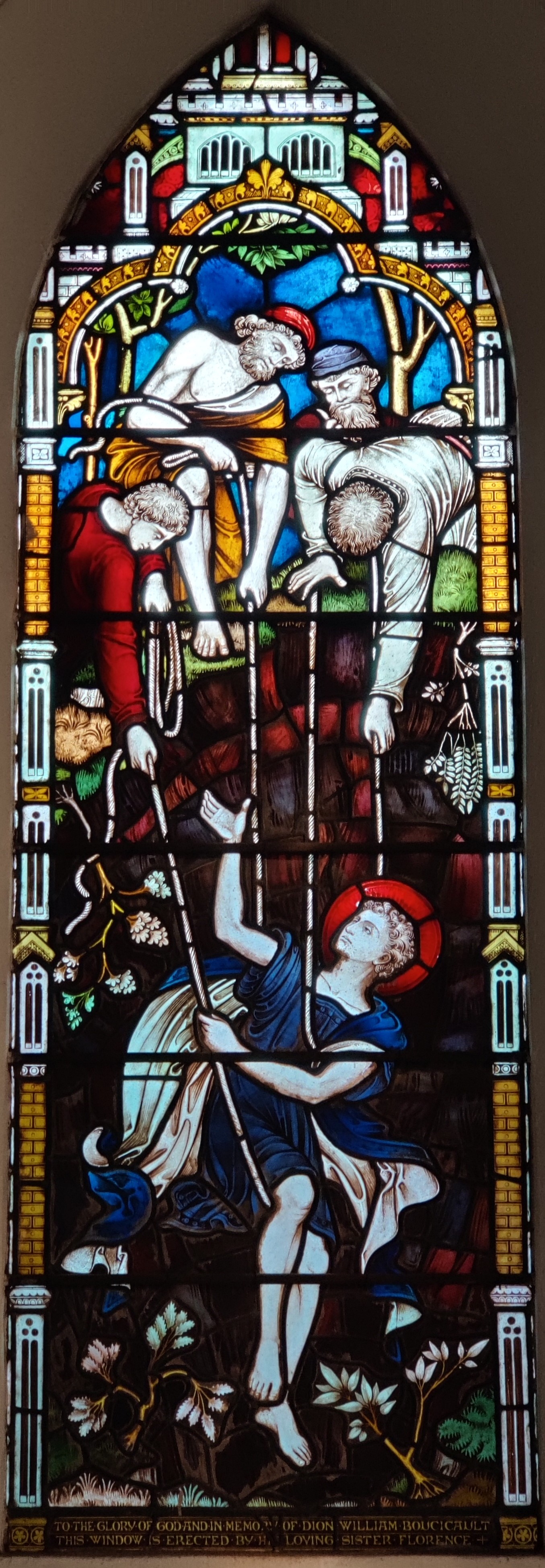 The dedication reads
The dedication reads
To the glory fo God and in memory of Dion William Boucicault
This window is erected by his loving sister Florence
We have no information about its installation and design, however it seems likely that Dion was the son of the famous Irish playwrite and actor Dion (Dionysius) Boucicault, who was killed in the Abbots Ripton Railway Disaster of 21 January 1876. There is a memorial to him in Huntington.
The Duke of Clarence Memorial Window
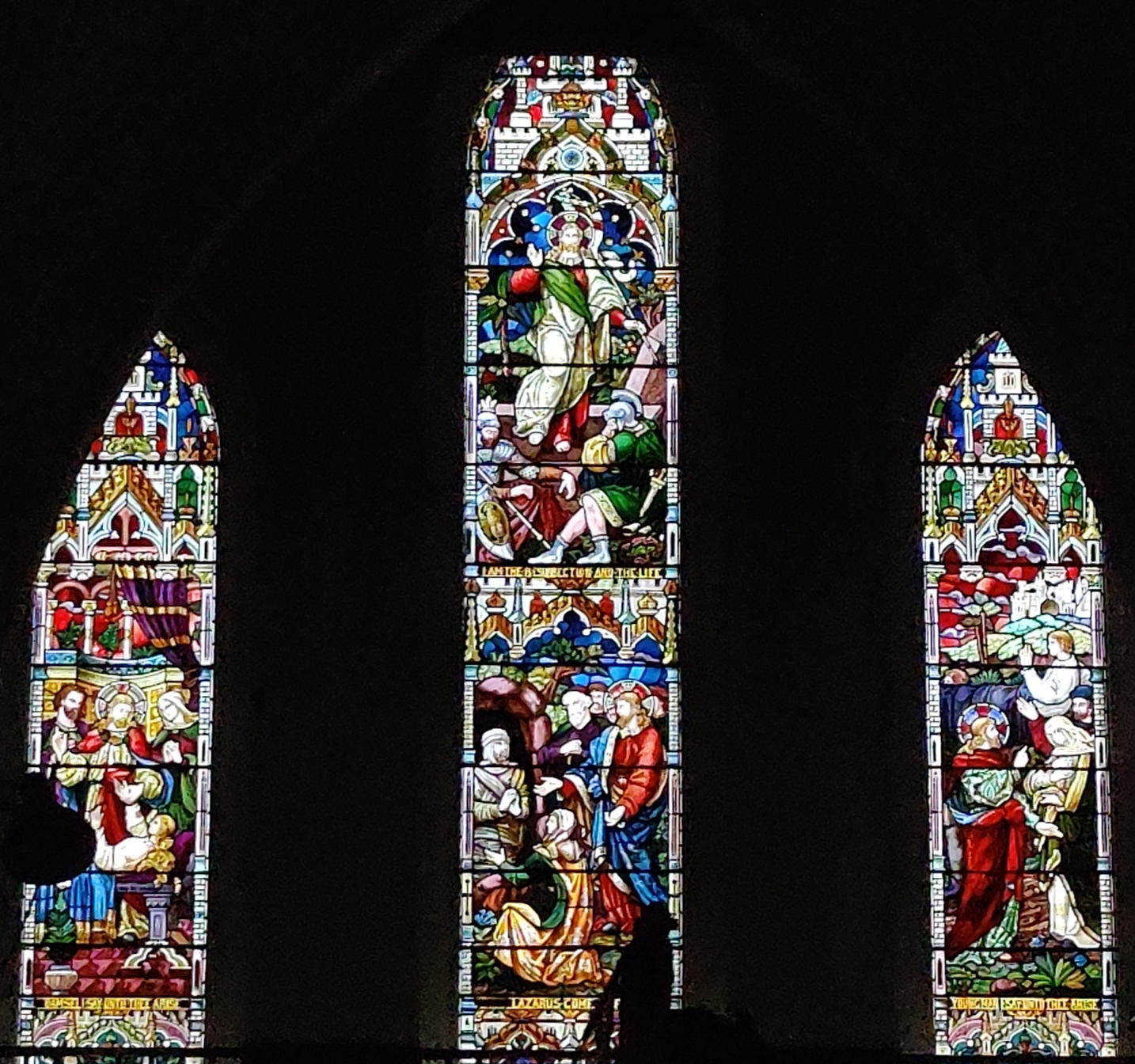 The Duke of Clarence Memorial Window is situated in the north gallery transept. It is a three light window dedicated to the memory of Albert Victor, Duke of Clarence KG, eldest son of King Edward VII and Queen Alexandra. The top half of the centre light depicts the Resurrection, below it the Raising of Lazarus and the lights either side show the Raising of the Widow’s son and the Raising of the Jarius’ daughter.
The Duke of Clarence Memorial Window is situated in the north gallery transept. It is a three light window dedicated to the memory of Albert Victor, Duke of Clarence KG, eldest son of King Edward VII and Queen Alexandra. The top half of the centre light depicts the Resurrection, below it the Raising of Lazarus and the lights either side show the Raising of the Widow’s son and the Raising of the Jarius’ daughter.
The window was designed by Mr F W Winter of London and was made by Messrs Sharp Bros of the Windsor Stained Glass Works, Sheet Street. Between the lights a dedication was painted on ribbon scrolls: In Memoriam Albert Victor Christian Edward of Wales KT KP Duke of Clarence and Avondale Born 8 January 1864 Died 14 January 1892 “Thy will be done”. Sadly someone in the intervening years thought it a good idea to paint over the dedication and other decorative paintwork in the church (it is hoped that the dedication can be reinstated sometime in the future).
It was unveiled by King Edward VII, then Prince of Wales, on 12 August 1892 in a private service attended by the rector, curate, wardens, organist. Afterwards the Prince of Wales visited the Albert Memorial Chapel where his son is buried. The window was the first memorial to the Duke of Clarence and was erected from funds collected by the Revd Arthur Robins (Rector 1873-99) who was at the time Chaplain in Ordinary to Queen Victoria and Chaplain to the Prince of Wales. The size of the window and its swift installation was perhaps due to the good relationship between Mr Robins and HRH, who would also have been a familiar sight to many parishioners as Holy Trinity as frequently worshipped here.
King Edward VII gave Mr Robins the beautiful autograph’ book which is still in use today (last signed by HRH the Earl of Wessex in 2014). It contains the signatures of many Royals (including Queen Elizabeth II when she visited the church as a child), aristocracy and politicians.
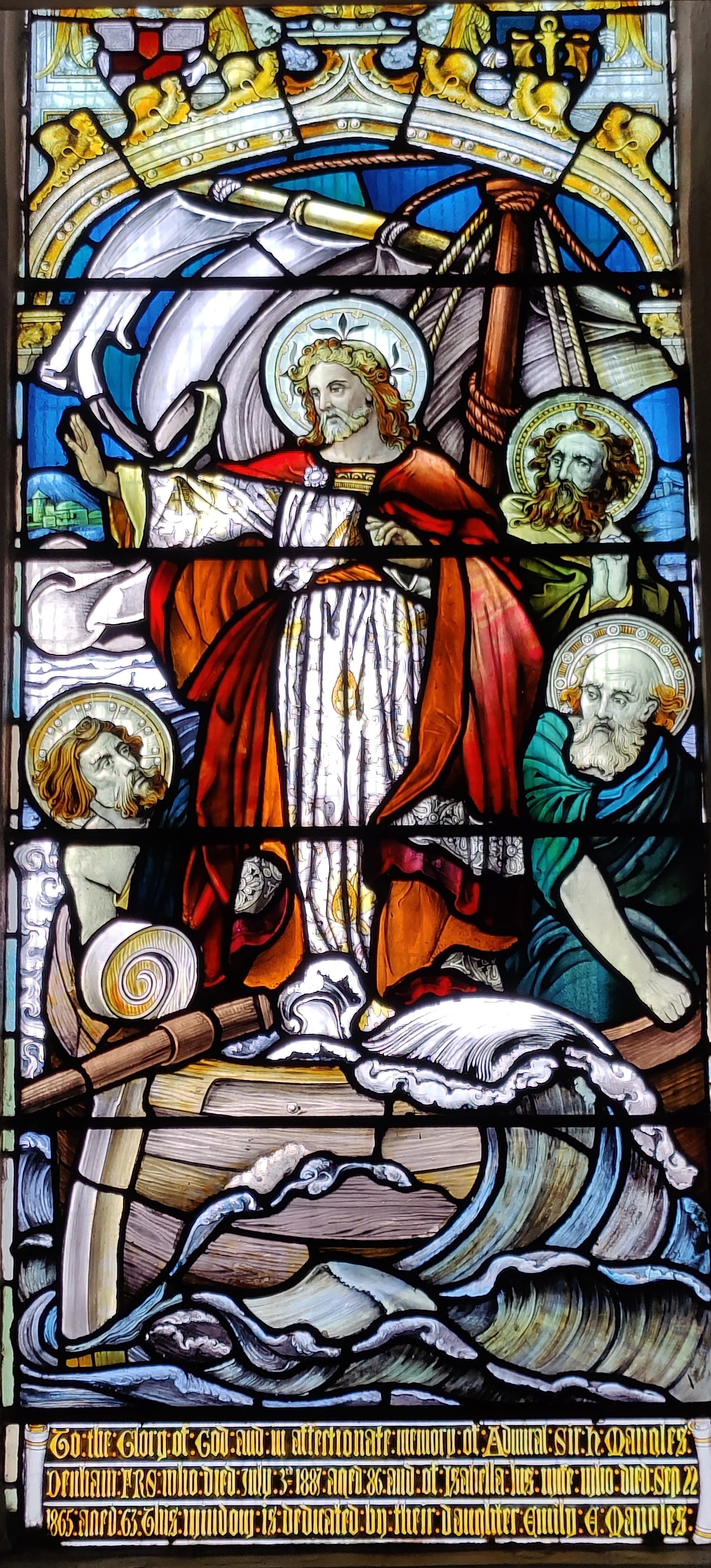
The window dedicated to Sir Henry Mangles Denham is situated on the north side of the church. It depicts Jesus in the boat with three disciples calming the storm (Matthew chapter 8, verse 26). The dedication at the bottom of the window reads “To the Glory of God and in affectionate memory of Admiral Sir H Mangles Denham FRS who died July 3rd 1887 aged 86 and of Isabella his wife who died Sep 22 1865 aged 63. This window is dedicated by their daughter Emily E Mangles.”
Sir Henry is best known for his work as a hydrographer charting the waters of Shark Bay in Australia in 1858 in HMS Herald. The town of Denham in Australia, twinned with Denham in Buckinghamshire, derives its name from Captain Henry Mangles Denham. Captain Denham was knighted at Windsor Castle on 26 March 1867 and retired from the Royal Navy in August 1877. He lived in London.
The window beside it is dedicated to another of Sir Henry’s daughters (Alicia Eliza Parker) and a window in the sanctuary, above the altar, is dedicated to Captain William H Mangles—Emily’s husband. Captain Mangles (of the 50th Queens Own Regiment) died at Clewer in 1868 aged 37 having succumbed to injuries received in the trenches before Sebastopol. Sir Henry is also the father of Annesley Turner Denham to whom a window on the south wall of All Saints, Frances Road, is dedicated by his widow.
Emily lived in Windsor and according to census records Annesley and his wife lived in Queens Terrace, Kings Road. Emily must have been a parishioner as she also gifted altar kneeling mats and alms bags, which she had worked.
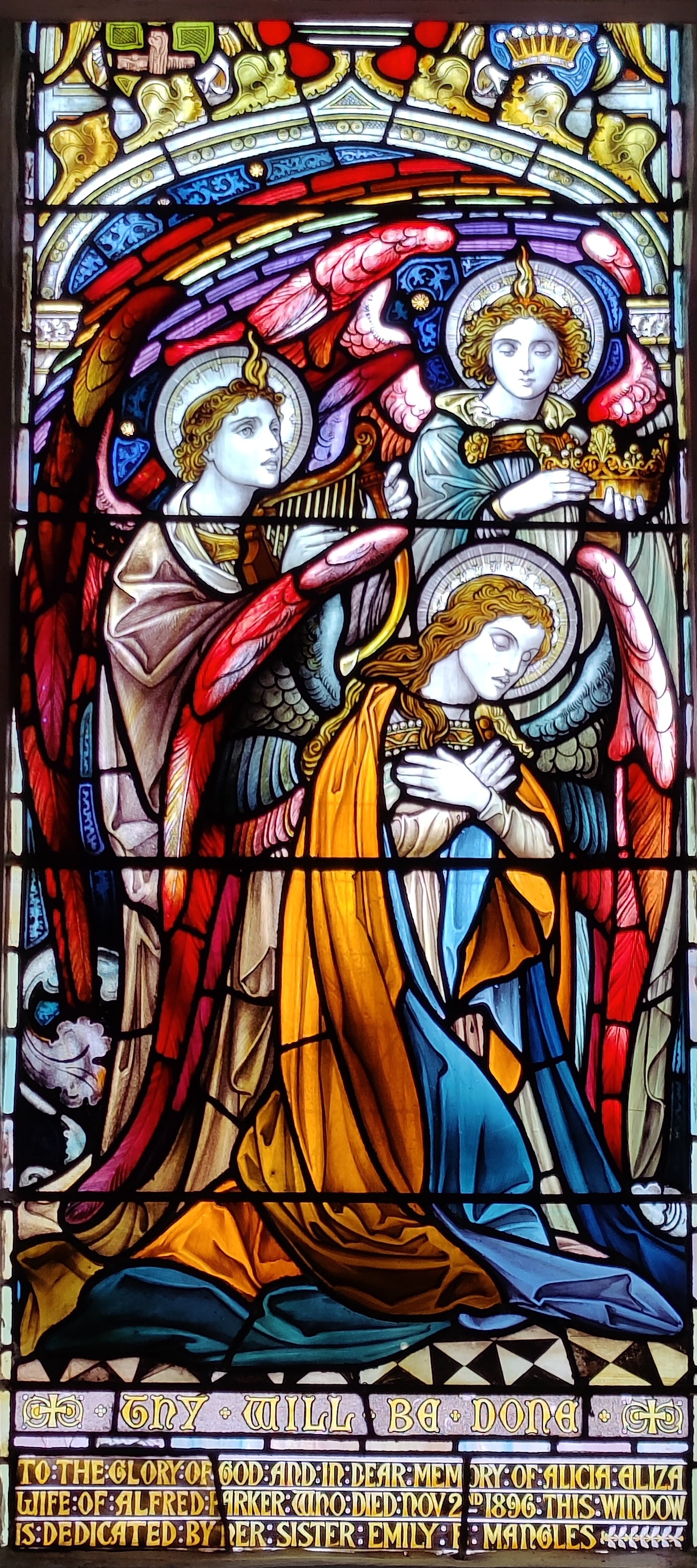
St Cecilia
The window in the south side of the church was pla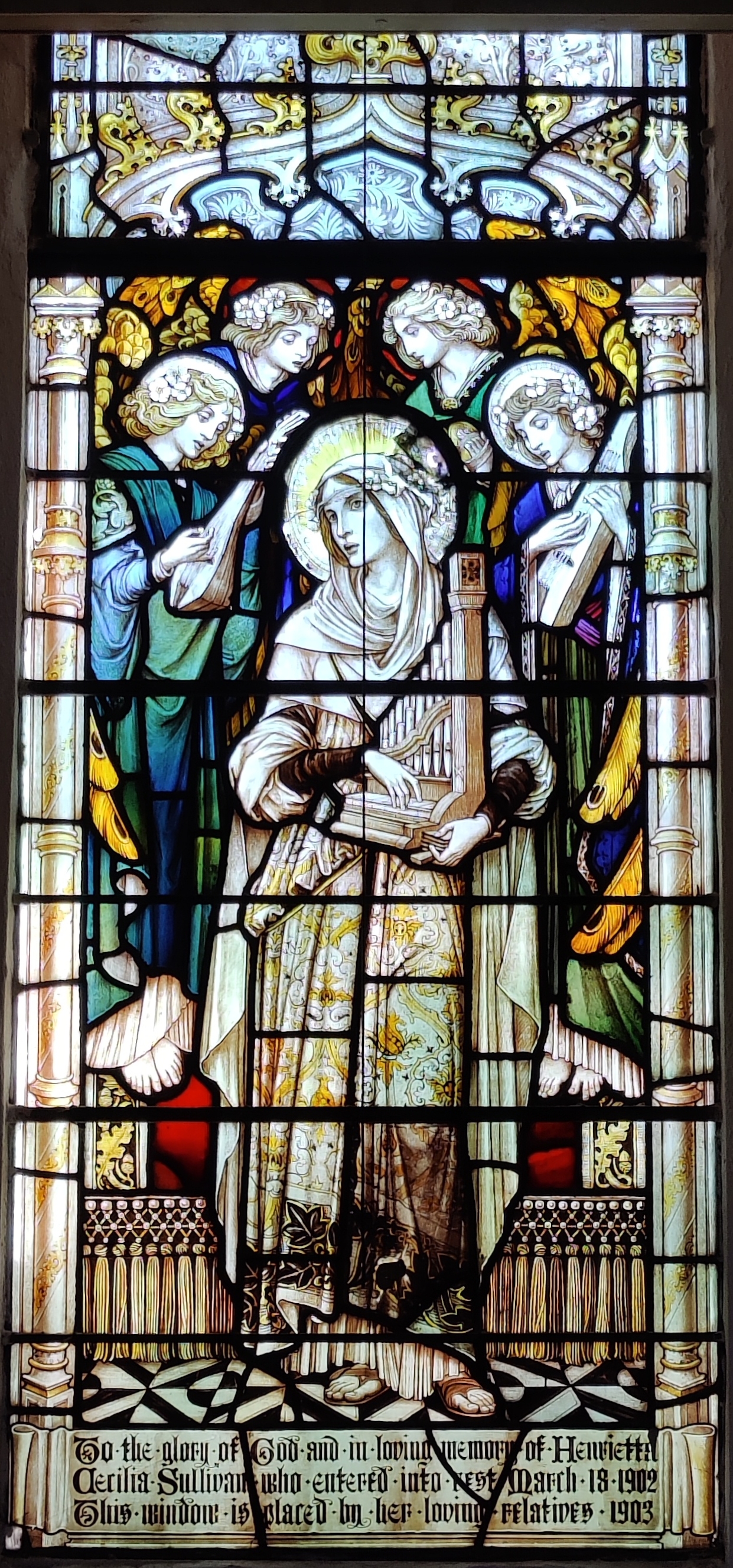 ced in memory of Henrietta Cecilia Sullivan, who had placed the Ascension Window in the North Gallery in memory of her sister Emily.
ced in memory of Henrietta Cecilia Sullivan, who had placed the Ascension Window in the North Gallery in memory of her sister Emily.
The Windsor & Eton Express of Saturday 7 November 1903 reports:
Memorial to the Late Miss H C Sullivan
A stained glass window to the memory of this excellent lady, who devoted her life to the welfare of Holy Trinity Parish, was unveiled on Saturday last at Holy Trinity Church. A very appropriate service of special prayers, hymns and address was conducted by the Rector – the Rev H Tower – at which many old friends and other members of the congregation were present. Miss Rogers, a niece of the deceased lady, unveiled the window, which is a very harmonious piece of colouring and adds considerably to the beauty of the Church. The design consists of a figure of St Cecilia (Miss Sullivan’s Christian name being Cecilia) playing an organ, with attendant angel figures in a floral canopy. It bears the following inscription: - “To the glory of God, and in loving memory of Henrietta Cecilia Sullivan who entered into rest March 18th, 1902. This window is placed by her loving relatives, 1903.”
The death notice in the Windsor & Eton Express of Saturday 22 March 1902 tells us that she was in her 78th year, lived at 7 Clarence Villas and was the daughter of the late John Sullivan Esq of the Madras Civil Service.
St Luke
The wind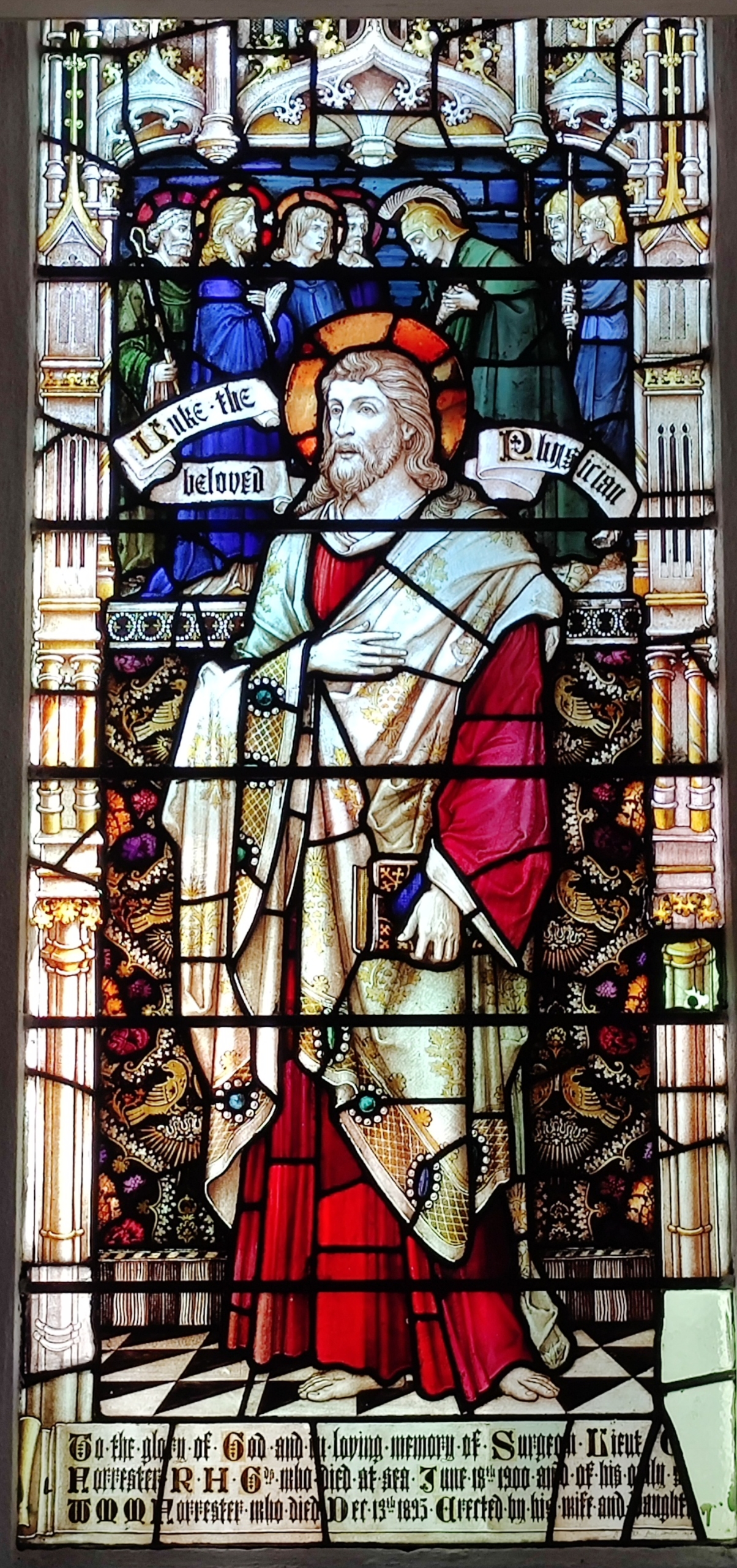 ow was unveiled at the same time as the South Africian Memorial which runs the length of the north and south walls of the church. The Windsor & Eton Express of Saturday 4 February 1905 says:
ow was unveiled at the same time as the South Africian Memorial which runs the length of the north and south walls of the church. The Windsor & Eton Express of Saturday 4 February 1905 says:
"…the unveiling of a stained glass window erected by his widow to the memory of Surgeon-Colonel Forrester, late of the Royal Horse Guards, who was in charge of Princess Christian’s hospital train in the South African War. It was designed by Mr Arthur Dix, and represents “St Luke”. At the foot is the inscription: “To the glory of God, and in loving memory of Surgeon Lieut-Colonel Forrester, Royal Horse Guards, who died in South Africa, June 18th, 1900; and of his only son William Forrester who died December 13th, 1895. Erected by his wife and daughter.”
Matthew, Mark, Luke & John (The Chapel)
The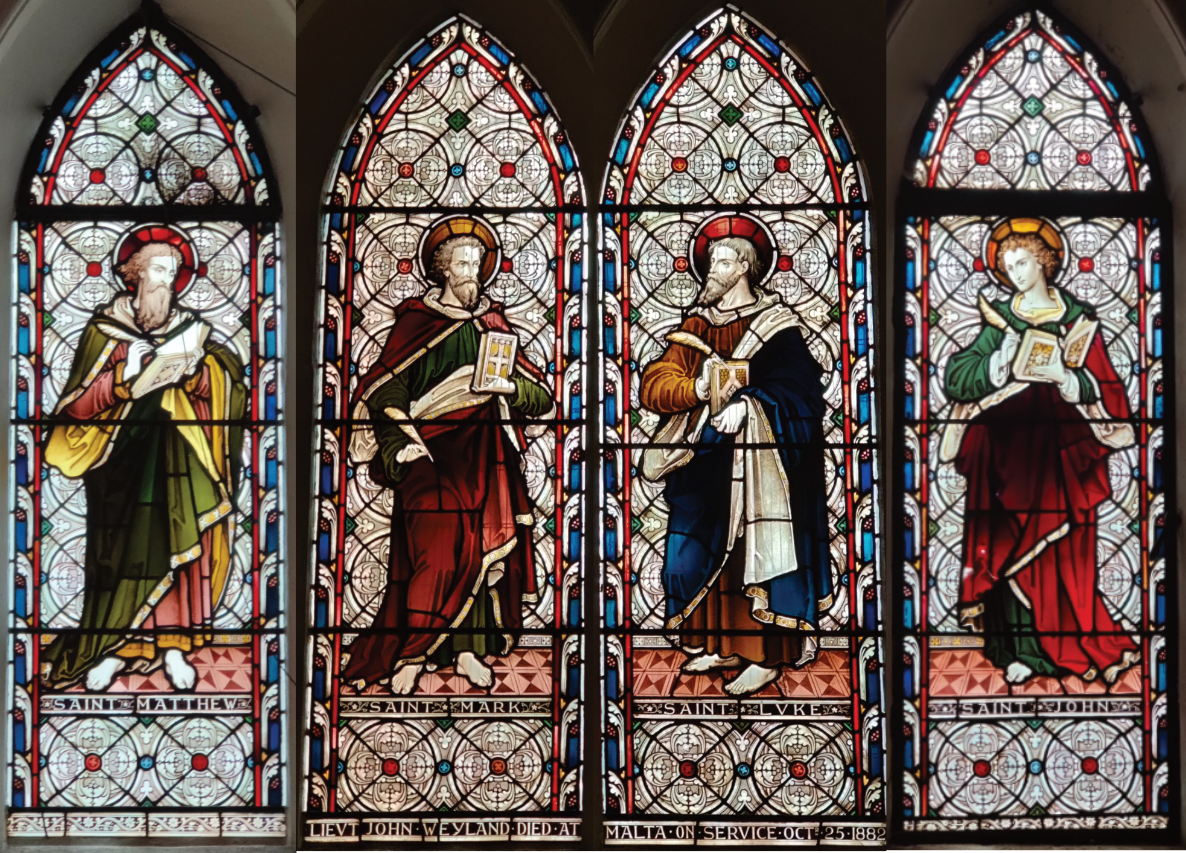 window is dedicated to Lieutenant John Weyland, we don't have any specific information regarding its installation and dedication, however, the Naval & Military Gazette and Weekly Chronicle of United Service of 1 November 1882 reports that:
window is dedicated to Lieutenant John Weyland, we don't have any specific information regarding its installation and dedication, however, the Naval & Military Gazette and Weekly Chronicle of United Service of 1 November 1882 reports that:
Lieutenant John Weyland, of the 1st Life Guards, died at the hospital in Malta on Wednesday last. He was the son of Mr John Weyland of Woodeaton, Oxfordshire, who married Lady Catherine De Burgh, daughter of the late Marquis of Clanricarde. Lieutenant Weyland was educated at Eton and Oxford, and entered the 1st Life Guards in 1876. Soon after the war commenced he was sent out with drafts for the squadron of his regiment in the field, and at Cyprus he contracted the fever known as Cyprus fever. He was removed to Malta, where he succumbed. He is the only officer which the Household Cavalry have lost during the Egyptian campaign.
